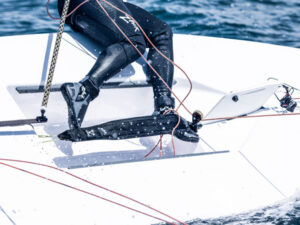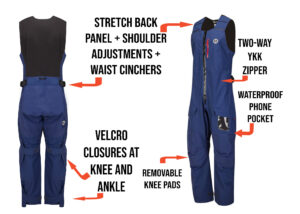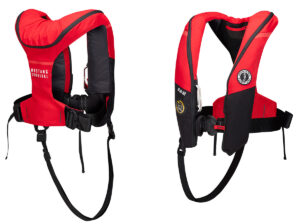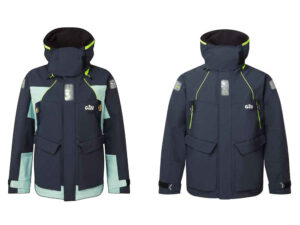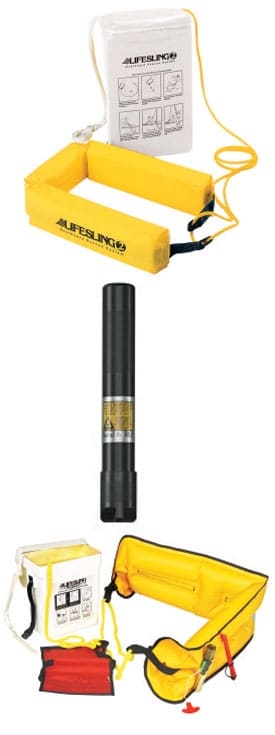
BestRecoveryGearPic
The primary purpose of the Crew Overboard Recovery Symposium, held last August on San Francisco Bay, was to assess conventional rescue methods. But another equally important component of the symposium was testing rescue and recovery equipment.
Some items, such as the LifeSling, were tried-and-true; others were new, some of which worked better than others. We’ll take a look at what was considered by the COB volunteers to be the best gear available, and we’ll also explain how it all works. This is gear that any boat should have and any crew should know how to use.
Strobe lights are the “come-and-get-me” lights of choice for offshore sailors. They’re bright and highly visible, but can be deceptive for rescuers. While testing lights at night, symposium volunteers observed that a strobe light was often lost in the clutter of lights ashore. They’re also tough on a helicopter pilot’s depth perception, which is why some models can be switched from flashing to always on.
Best among all the lights wasn’t a white strobe, it was the Rescue Laser Flare, which, when turned on, drew a collective “ooh” from observers half a mile away. The Rescue Laser Flare is a marinized laser pointer with a lens that distorts the circular beam of red light into a line, making it easier to see. In fact, at 16 miles, the “fan” of light from the Laser Flare is 6,000 feet wide, which makes attracting rescuers more likely. Tests have shown the Laser Flare to be visible from up to 28 miles away, which beats any normal flare hands down. The Laser Flare is also useful for a crew searching for a COB, because it lights up the reflective tape on foul weather gear or lifejackets. The largest model, which sells for $109.95, weighs only 6 ounces, is waterproof to 80 feet, and will stay lit for 72 hours on two AA batteries. This is a must-have piece of gear that every sailor should carry. www.greatlandlaser.com
While the Rescue Laser Flare was praised, other products tested well, including the Surefire, a flashlight used for police and military applications. This incredibly bright flashlight, designed to blind enemy troops or criminals, is expensive (starting at $80), and eats up Lithium batteries, but no other flashlight was brighter. www.surefire.com
Cyalume lightsticks, activated by bending the plastic tube, breaking an inner vial, and shaking, turned out to be much brighter than testers thought they would be, so a couple of these inexpensive, one-use lights should be part of your personal safety gear and in your ditch bag. A Cyalume stick on a lanyard can be spun around in circles for greater attraction.
Strobes are still an important piece of rescue gear, especially water-activated styles like the ACR Waterbug FireFly2, which can be attached to a lifejacket. If a victim goes overboard unconscious, or is unable to turn on manually operated devices, this water-activated strobe light will help rescuers in their search. www.acrelectronics.com
If you own or race on a boat 20 feet or longer, you’re probably familiar with the LifeSling package, a white rectangle attached somewhere near the stern. Common as they may be, not everyone knows how to use or deploy it, as we discovered during one of our first COB attempts. Inside the white container is a U-shaped foam collar and 125 or 150 feet of braided polypropylene line. The premise of the LifeSling is simple; it’s a life ring with a line attached. Where a life ring would simply provide flotation, the LifeSling keeps the COB tethered to the boat. If the LifeSling is deployed quickly enough, the COB can grab it; if he misses, the helmsman simply steers circles around the COB, drawing the LifeSling ever nearer with each turn.
Practice with a LifeSling is highly recommended, but we have two caveats: when re-packing the LifeSling, don’t try to coil the line, carefully stuff it in two or three feet at a time so it will come out of its container tangle-free when the LifeSling is thrown. Although the Velcro patches at the end of the arms of the U look like they need to be stuck together avoid the temptation; it’s very hard for a person in the water to slip the sling over their head and shoulders when closed. From $99, www.westmarine.com
We tested the new inflatable LifeSling as well, and found that it performed well, once we remembered to arm it with a CO2 cartridge. On the first day of testing, nearly every boat equipped with the inflatable LifeSling wrongly assumed its unit was armed. They weren’t.
Getting the COB alongside the boat is half the battle. The water-sodden, most likely exhausted, and most probably panicked victim still must be brought aboard. To lift them to the deck with a mechanical aid is helpful. A simple technique is the Elevator Method, in which an end of a sheet or other long line is led forward and cleated. The line is then lowered into the water in a bight that extends from near the boat’s bow back to a winch. The COB steps or sits on the shallow bight and holds on tight to a stanchion or short piece of rope. A crewmember grinds the line in with the winch, slowly raising the victim out of the water.
Weak victims will have trouble with this technique, as it requires a fair bit of upper body strength, so a LifeSling 3:1 Tackle is a good addition ($125). The Tackle attaches to a halyard, and using two blocks and 65 feet of braided line, gives a 3-to-1 purchase. A fiddle block attaches to a halyard and the bottom block’s carabineer is attached to the victim. The victim can be retrieved manually or the line led back to a winch. Remember to use a downhaul on the halyard so it doesn’t get pulled up the rig.
One time-honored COB technique is, once a person is lost, to throw everything that floats in the hope that something will either keep the victim afloat, or lead you back to them. Modern variations on this technique are the MOM units, 8 and 9. Once the handle on the top of the MOM box is pulled, a cornucopia of lifesaving goodies tumble out and begin to inflate. In the MOM 8 is a 6-foot pylon with an 8-hour, Lithium-Ion battery powered light on top; a horseshoe flotation device with 40 pounds of buoyancy; and a 16-inch sea anchor. All are attached together with polypropylene line. Gravity-activated CO2 cartridges inflate the pylon and the horseshoe within 5 seconds. The MOM 9 unit adds a one-man life raft and another sea anchor to the package.
These are both excellent units, especially for offshore racers. If the MOM is deployed immediately and the COB is conscious, they’ll stand a much better chance of survival if they can get to the MOM gear. These units must be re-packed every two years, so at the end of the cycle, think about deploying the MOM for a COB drill. During one deployment, we saw how a MOM could be badly packed, as the line wrapped around the pylon during inflation, causing it to fold in half, so careful packing of this unit is recommended. From $795, www.switlick.com
One of the least expensive and most overlooked pieces of gear is the basic heaving line, and a favorite of the COB symposium was Markus Lifenet’s Rescue-lines. This Icelandic company makes many types of commercial safety gear, most of which is too large and bulky to be carried aboard a raceboat, but their Rescue-line is perfect for any size vessel. It’s basically a bag filled with 75 feet of polypropylene line and a harness. The thrower holds the bitter end in his non-throwing hand and throws the bag. All who used the Rescue-line were impressed at how far the bag could be thrown, as long as it’s thrown underhand. www.markuslifenet.com

